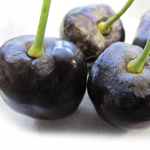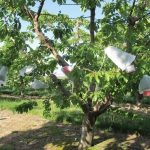New findings by Washington State University scientists show why powdery mildew can be so hard to control in cherries. Fruit are susceptible nearly all season long.
Powdery mildews are a large group of fungi containing around 850 different species. They affect a wide range of crops, from tree fruit, grapes, and hops to strawberries and small grains.
The cherry powdery mildew is Podosphaera clandestine and, like all powdery mildews, it’s an extremely needy pathogen, requiring perfect environmental conditions and a living and susceptible host to grow and produce the disease.
Scientists have known about powdery mildew for some 250 years, says Dr. Claudia Probst, postdoctorate research associate at WSU. Yet, there are still many unanswered questions. “That’s partially because it’s so hard to work with obligate biotrophic fungi (that can only reproduce on living cells) in the laboratory.
To do lab work, we use small humidity chambers using specific temperature and humidity regimes to create the disease, but much of our work must be done in orchards.”
Probst, who is working with Dr. Gary Grove, plant pathologist and director of WSU’s Irrigated Research and Extension Center in Prosser, presented her research during the annual Cherry Institute meeting held in January in Yakima, Washington.
Probst and Grove want to better understand the epidemiology of powdery mildew on sweet cherries so growers can improve pest management strategies. Disease control is even more important these days with the opening of new foreign markets.
Susceptibility
In some crops, the fruit’s resistance to powdery mildew increases as they age during the growing season. “Most fruit crops, like babies, are most susceptible to powdery mildew in the early stages of fruit development,” she said. Infants are initially at high risk for diseases, but develop immunities as they get older to ward off diseases.
But not so with sweet cherries. In fact, Probst says the reverse happens.

Claudia Probst
In crops like grapes and hops, research has shown that fruit and flowers are most susceptible early in the season. Because of that, growers concentrate fungicide sprays during this vulnerable, hypersensitive time near bloom, but they can back off spraying later in the season, although sprays for foliage infection are often needed.
“Surprisingly, cherries are most resistant to powdery mildew early on and lose their resistance as fruit develop, becoming least resistant near maturity at harvest,” Probst said.
To study fruit susceptibility, experiments were conducted in an orchard of Bing and Sweetheart cherries that had a history of powdery mildew.
Researchers used specially made bags from nylon mesh material used in aquaculture. The material is fine enough to prevent powdery mildew spores (conidia) from moving in or out. The bags allowed researchers to inoculate fruit with a known amount of conidia and track disease development throughout the season.
From the onset of fruit set, fruit from five treatments in the study were covered with the bags. In each treatment, half the fruit were inoculated with conidia and immediately covered and the other half remained uncovered for two weeks to allow disease exposure to occur naturally.
After either inoculation or exposure for two weeks, fruit of that treatment were covered for the remainder of the study. The timeline started at 24 days after full bloom, because that’s when disease was first observed in the orchard, and concluded around 90 days post bloom, which was near harvest.
At the end of the trial, each treatment had been exposed naturally for a different two-week period, which allowed Probst to control and assess the timing of fruit infection. Fruit needed to be exposed naturally as well as by inoculation so she could compare overall disease incidence in the orchard at the end of the study. She found infection on fruit naturally exposed (not covered) in the orchard at 80 days post bloom.
Probst found that all timings of Sweetheart and Bing cherries, inoculated with 5,000 spores per milliliter, resulted in some fruit infection at harvest. The one-year susceptibility study raises further questions. For example, how many spores are needed to cause an infection?
How long do spores survive in natural settings without covers? Literature has shown powdery mildew spores generally survive a couple of days, says Probst.
The study also reinforces the need for an effective pest management strategy, said Probst. Spraying cherry orchards with fungicides after harvest may be a way to knock down spore concentrations for the following season. Grove has been working on postharvest fungicide sprays as a way to reduce spore concentrations on postharvest foliage that otherwise can overwinter and trigger infection the following spring.
Spore concentration
A separate one-year trial looked at five concentration levels of spores (10,000, 5,000, 1,000, 500, and 100 per ml) to learn the threshold needed to cause infection at different developmental stages. Fruit were covered with the special bags and inoculated with different spore concentrations at three different dates (May 29, June 12, and June 26) to represent early, mid, and late timing of the season.
“It took fruit inoculated with 500 spores in early season to result in 26 percent infection of fruit at harvest,” Probst said. “But fruit late in the season, inoculated with 500 spores, had 76 percent of fruit infected at harvest.”
She explained this shows that disease development is a function of both growth stage and inoculum concentration. “The conidial concentration needed to cause significant disease at harvest is dependent on developmental age of fruit. The younger the fruit, the more spores are needed.”
Research funding from the Washington Tree Fruit Research Commission will allow WSU to develop molecular technology to learn more about spore viability. Future research will also look at impact from spore density and management practices. •








Leave A Comment